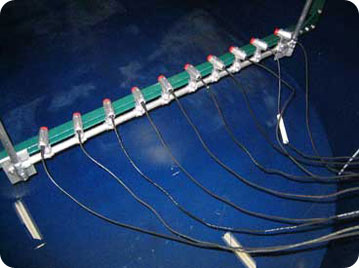People have been using sound to probe the ocean depths for decades. Navies track ships and submarines. Archaeologists hunt for sunken cities. Oceanographers measure ocean currents, and geologists map the ocean floor.
 A top view of the line of receivers used to collect sound data. Credit: UC San Diego/J. Jaffe
A top view of the line of receivers used to collect sound data. Credit: UC San Diego/J. JaffeAnd in the decades to come, marine biologists may use sound to probe ocean life like never before. For example, scientists studying microscopic creatures in the upper layers of the oceans may be able to identify the different kinds without disturbing their subjects.
At the Scripps Institution of Oceanography scientists are pioneering this new technology, where they are learning how to use sonar in a new way.
Sonar sends out pulses of sound, then records the “echoes” as the sound reflects off of solid objects. Computers convert the echoes into pictures or other information.
Today, sonar systems use a single device to transmit and receive sound. But the Scripps researchers are experimenting with systems that use several receivers. Tests in the lab show that this technique produces a much more detailed view. For example, the researchers could tell the difference between the tiny shrimp-like creatures known as krill and another class of tiny creatures known as copepods.
The researchers are testing the technique in the ocean this fall. If it pans out, it could help future biologists learn much more about how creatures large and small behave in the open ocean -- all without getting wet.
This episode of Science and the Sea was made possible with financial support from California Sea Grant.

